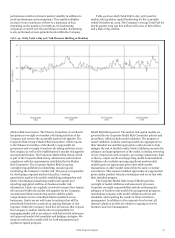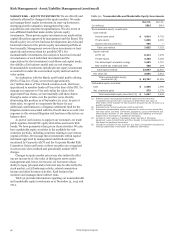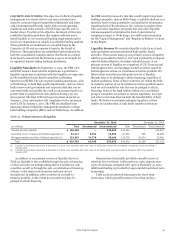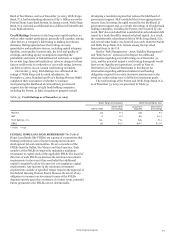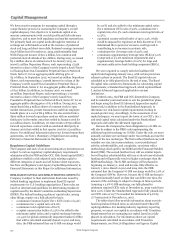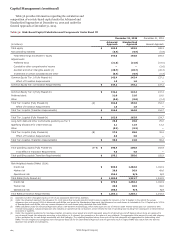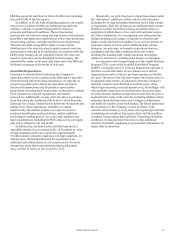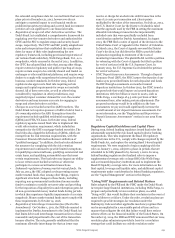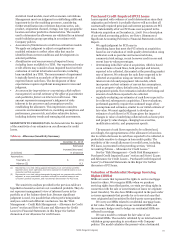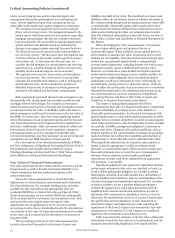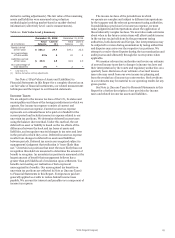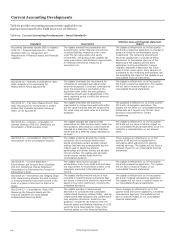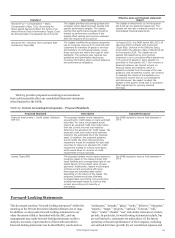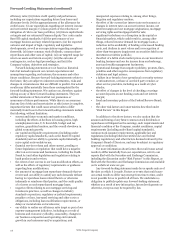Wells Fargo 2015 Annual Report Download - page 108
Download and view the complete annual report
Please find page 108 of the 2015 Wells Fargo annual report below. You can navigate through the pages in the report by either clicking on the pages listed below, or by using the keyword search tool below to find specific information within the annual report.
Capital Management (continued)
SUPPLEMENTARY LEVERAGE RATIO In April 2014, federal
banking regulators finalized a rule that enhances the SLR
requirements for BHCs, like Wells Fargo, and their insured
depository institutions. The SLR consists of Tier 1 capital under
Basel III divided by the Company’s total leverage exposure. Total
leverage exposure consists of the total average on-balance sheet
assets, plus off-balance sheet exposures, such as undrawn
commitments and derivative exposures, less amounts permitted
to be deducted from Tier 1 capital. The rule, which becomes
effective on January 1, 2018, will require a covered BHC to
maintain a SLR of at least 5.0% (comprised of the 3.0%
minimum requirement and a supplementary leverage buffer of
2.0%) to avoid restrictions on capital distributions and
discretionary bonus payments. The rule will also require that all
of our insured depository institutions maintain a SLR of 6.0%
under applicable regulatory capital adequacy guidelines. In
September 2014, federal banking regulators finalized additional
changes to the SLR requirements to implement revisions to the
Basel III leverage framework finalized by the BCBS in January
2014. These additional changes, among other things, modify the
methodology for including off- balance sheet items, including
credit derivatives, repo-style transactions and lines of credit, in
the denominator of the SLR, and will become effective on
January 1, 2018. At December 31, 2015, our SLR for the
Company was 7.7% assuming full phase-in of the Basel III
Advanced Approach capital framework. Based on our review, our
current leverage levels would exceed the applicable requirements
for each of our insured depository institutions as well. The fully
phased-in SLR is considered a non-GAAP financial measure that
is used by management, bank regulatory agencies, investors and
analysts to assess and monitor the Company’s leverage exposure.
See Table 59 for information regarding the calculation and
components of the SLR.
Table 59: Basel III Fully Phased-In SLR
(in billions) December 31, 2015
Tier 1 capital $ 162.8
Total average assets 1,787.3
Less: deductions from Tier 1 capital 29.6
Total adjusted average assets 1,757.7
Adjustments:
Derivative exposures 63.2
Repo-style transactions 3.3
Other off-balance sheet exposures 292.3
Total adjustments 358.8
Total leverage exposure $ 2,116.5
Supplementary leverage ratio 7.7%
OTHER REGULATORY CAPITAL MATTERS In October 2015,
the FRB proposed rules to address the amount of equity and
unsecured long-term debt a U.S. G-SIB must hold to improve its
resolvability and resiliency, often referred to as Total Loss
Absorbing Capacity (TLAC). Under the proposed rules, U.S. G-
SIBs would be required to have a minimum TLAC amount
(consisting of CET1 capital and additional tier 1 capital issued
directly by the top-tier or covered BHC plus eligible external
long-term debt) equal to the greater of (i) 18% of RWAs and (ii)
9.5% of total leverage exposure (the denominator of the SLR
calculation). Additionally, U.S. G-SIBs would be required to
maintain a TLAC buffer equal to 2.5% of RWAs plus the firm’s
applicable G-SIB capital surcharge calculated under method one
plus any applicable countercyclical buffer that would be added to
the 18% minimum in order to avoid restrictions on capital
distributions and discretionary bonus payments. The proposed
rules would also require U.S. G-SIBs to have a minimum amount
of eligible unsecured long-term debt equal to the greater of (i)
6.0% of RWAs plus the firm’s applicable G-SIB capital surcharge
calculated under method two and (ii) 4.5% of the total leverage
exposure. In addition, the proposed rules would impose certain
restrictions on the operations and liabilities of the top-tier or
covered BHC in order to further facilitate an orderly resolution,
including prohibitions on the issuance of short-term debt to
external investors and on entering into derivatives and certain
other types of financial contracts with external counterparties.
The proposed rules were open for comments until
February 1, 2016. If the proposed rules are finalized as proposed,
we may be required to issue additional long-term debt. We
continue to evaluate the impact this proposal will have on our
consolidated financial statements.
In addition, as discussed in the “Risk Management –
Asset/Liability Management – Liquidity and Funding –
Liquidity Standards” section in this Report, a final rule
regarding the U.S. implementation of the Basel III LCR was
issued by the FRB, OCC and FDIC in September 2014.
Capital Planning and Stress Testing
Our planned long-term capital structure is designed to meet
regulatory and market expectations. We believe that our long-
term targeted capital structure enables us to invest in and grow
our business, satisfy our customers' financial needs in varying
environments, access markets, and maintain flexibility to return
capital to our shareholders. Our long-term targeted capital
structure also considers capital levels sufficient to exceed Basel
III capital requirements including the G-SIB surcharge.
Accordingly, based on the final Basel III capital rules under the
lower of the Standardized or Advanced Approaches CET1 capital
ratios, we currently target a long-term CET1 capital ratio at or in
excess of 10%, which assumes a 2% G-SIB surcharge. Our capital
targets are subject to change based on various factors, including
changes to the regulatory capital framework and expectations for
large banks promulgated by bank regulatory agencies, planned
capital actions, changes in our risk profile and other factors.
Under the FRB’s capital plan rule, large BHCs are required
to submit capital plans annually for review to determine if the
FRB has any objections before making any capital distributions.
The rule requires updates to capital plans in the event of
material changes in a BHC’s risk profile, including as a result of
any significant acquisitions. The FRB assesses the overall
financial condition, risk profile, and capital adequacy of BHCs
while considering both quantitative and qualitative factors when
evaluating capital plans.
Our 2015 CCAR, which was submitted on January 2, 2015,
included a comprehensive capital plan supported by an
assessment of expected sources and uses of capital over a given
planning horizon under a range of expected and stress scenarios,
similar to the process the FRB used to conduct the CCAR in
2014. As part of the 2015 CCAR, the FRB also generated a
supervisory stress test, which assumed a sharp decline in the
economy and significant decline in asset pricing using the
information provided by the Company to estimate performance.
The FRB reviewed the supervisory stress results both as required
under the Dodd-Frank Act using a common set of capital actions
for all large BHCs and by taking into account the Company’s
proposed capital actions. The FRB published its supervisory
stress test results as required under the Dodd-Frank Act on
March 5, 2015. On March 11, 2015, the FRB notified us that it did
not object to our capital plan included in the 2015 CCAR. The
Wells Fargo & Company
106



